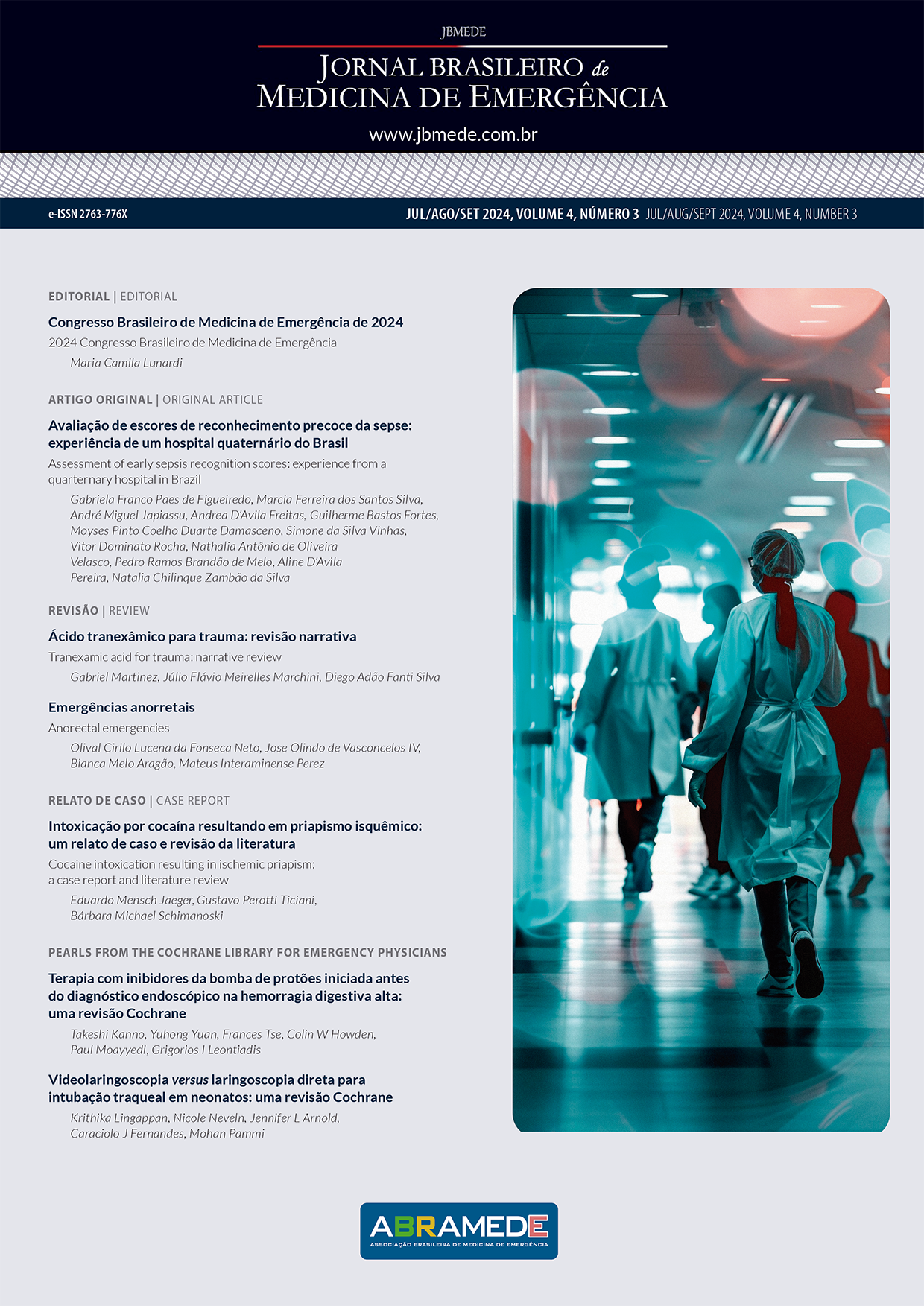Assessment of early sepsis recognition scores: experience from a quarternary hospital in Brazil
Main Article Content
Abstract
Objective: To analyze the effectiveness of screening tools for the early detection of sepsis. Methods: A prospective study that included 443 sepsis protocols from a quaternary hospital in Rio de Janeiro between January and August 2023. The sensitivity and specificity of three tools were compared: Systemic Inflammatory Response Syndrome (SIRS), quick Sepsis Related Organ Failure Assessment (qSOFA), and National Early Warning Score (NEWS). Results: Among patients with septic shock, 88% had a NEWS score > 4, while 74% of sepsis cases also had this score. NEWS stood out with a sensitivity of 87% for septic shock and 74% for sepsis, outperforming the other tools in both cases. Additionally, qSOFA was more specific, with 89% specificity for sepsis. Most patients were elderly and female, with initial screening indicating a high level of risk. Conclusion: The study underscores the importance of early identification of sepsis, recommending the use of NEWS as the primary tool in emergency services. Although conducted at a single center, the findings encourage the adoption of NEWS-based protocols to improve outcomes in sepsis management.
Article Details

This work is licensed under a Creative Commons Attribution 4.0 International License.
References
1. Brasil. Ministério da Saúde. Biblioteca Virtual da Saúde. 13/9 – Dia
Mundial da Sepse. [citado 2024 Ago 5]. Disponível em: https://
bvsms.saude.gov.br/13-9-dia-mundial-da-sepse-3/
2. Rudd KE, Johnson SC, Agesa KM, Shackelford KA, Tsoi D, Kievlan
DR, et al. Global, regional, and national sepsis incidence and
mortality, 1990-2017: analysis for the Global Burden of Disease
Study. Lancet. 2020;395(10219):200-211.
3. Gavelli F, Castello LM, Avanzi GC. Management of sepsis and
septic shock in the emergency department. Intern Emerg Med.
2021;16(6):1649-61.
4. Sousa AS, Soares GR, Severo LT, Oliveira AP, Santarém MD,
Caregnato RC. Escores utilizados em suspeita/diagnóstico de
sepse. Rev Enferm UERJ. 2022;30:e67662.
5. Brasil. Ministério da Educação. Empresa Brasileira de Serviços
Hospitalares. Escore para alerta precoce. Brasília, DF: Ministério
da Educação; 2020 [citado 2024 Ago 5]. Disponível em: https://
www.gov.br/ebserh/pt-br/hospitais-universitarios/regiaosudeste/
hu-ufjf/saude/escore-para-alerta-precoce-1/escorepara-
alerta-precoce
6. Lohn A, Martins MS, Câmara LT, Malfussi LB, Lazzari DD,
Nascimento ER, et al. Perfil epidemiológico e clínico de pacientes
com suspeita de sepse e choque séptico em emergência hospitalar.
Reme: Rev Min Enferm. 2021;25:e-1415.
7. Singer M, Deutschman CS, Seymour CW, Shankar-Hari M, Annane
D, Bauer M, et al. The Third International Consensus Definitions for
Sepsis and Septic Shock (Sepsis-3). JAMA. 2016;315(8):801-10.
8. Usman OA, Usman AA, Ward MA. Comparison of SIRS, qSOFA,
and NEWS for the early identification of sepsis in the Emergency
Department. Am J Emerg Med. 2019;37(8):1490-7.
9. Chakraborty RK, Burns B. Systemic Inflammatory Response
Syndrome. [Updated 2023 May 29]. In: StatPearls [Internet].
Treasure Island (FL): StatPearls Publishing; 2024 Jan-.
10. Lohn A, Martins MS, Câmara LT, Malfussi LB, Lazzari DD,
Nascimento ER, et al. Perfil epidemiológico e clínico de pacientes com suspeita de sepse e choque séptico em emergência hospitalar.
Reme: Rev Min Enferm. 2021;25:e-1415.
11. Latin American Sepsis Institute. Grupo Brasileiro de Avaliação de
Risco. Associação entre Sistema Manchester de Classificação de Risco
e Protocolo de Sepse. [citado 2024 Ago 5]. Disponível em: https://ilas.
org.br/wp-content/uploads/2022/07/nota-tecnica01-2017.pdf
12. Instituto Latino Americano de Sepse. Implementação de protocolo
gerenciado de sepse protocolo clínico. [citado 2024 Ago 5].Disponível em: https://ilas.org.br/wp-content/uploads/2022/02/
protocolo-de-tratamento.pdf
13. Mok K, Christian MD, Nelson S, Burry L. Time to Administration of
Antibiotics among Inpatients with Severe Sepsis or Septic Shock.
Can J Hosp Pharm. 2014;67(3):213-9.
14. Artigos sobre testes diagnósticos. [citado 2024 Out 1]. Disponível
em: https://www.sboc.org.br/app/webroot/leitura-critica/LEITURACRITICA_
C5.pdf

